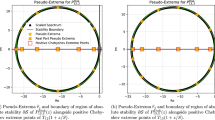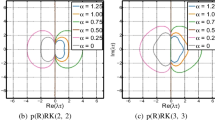Abstract
We study the relative merits of the phase-lag property of Runge-Kutta pairs and we propose new explicit embedded pairs for the numerical solution of first order differential systems with periodical solution. We analyze two families of 5(4) paris and one family of 6(5) pairs with respect to the attainable phase-lag order. From each family we choose a pair with the highest achievable phase-lag order, optimized with respect to a measure of the magnitude of its truncation error coefficients. The new 5(4) algebraic order pairs are of phase-lag order 8(4) and 8(6) and they are both non-dissipative, while the 6(5) pair is dissipative and of phase-lag order 10(6). The new pairs exhibit an improved performance, in comparison with other currently known general and special purpose methods, when they are applied to semidiscretized hyperbolic equations and problems describing free and weakly forced oscillations.
Zusammenfassung
Wir studieren die relativen Vorteile des Phasenfehler-Merkmals von Runge-Kutta-Paaren und schlagen in der vorliegenden Arbeit neue direkte Paare von Runge-Kutta-Methoden für die numerische Lösung von Differentialgleichungssystemen erster Ordnung mit periodischen Lösungen vor. Wir betrachten Familien von Paaren der algebraischen Ordnung 5(4) bzw. 6(5) bezüglich der erreichbaren Ordnung des Phasenfehlers. Von jeder Familie wählen wir ein Paar mit der höchsten Ordnung des Phasenfehlers aus, mit einer Optimierung der Koeffizienten des Abbrechfehlers. Die neuen Paare der algebraischen Ordung 5(4) haben Phasenfehler der Ordnung 8(4) und 8(6). Das Paar der algebraischen Ordnung 6(5) hat die Phasenordnung 10(6). Die neuen Paare von Methoden sind effektiver als andere bekannte Methoden, wenn sie auf semidiskrete hyperbolische Gleichungen und Problemen, die freie und schwachgedämpfte Schwingungen beschreiben, angewandt werden.
Similar content being viewed by others
References
Brusa, L., Nigro, L.: A one-step method for direct integration of structural dynamic equations. Intern. J. Numer. Methods Eng.15, 685–699 (1980).
Butcher, J. C.: On Runge-Kutta processes of high order. J. Aust. Math. Soc.4, 179–194 (1964).
Butcher, J. C.: Numerical analysis of ordinary differential equations. New York: J. Wiley 1987.
Chawla, M. M., Rao, R. S.: A Numerov-type method with minimal phase-lag for the integration of second order periodic initial-value problems II. Explicit method, J. Comput. Appl. Math.15, 329–337 (1986).
Chawla, M. M., Rao, P. S.: An explicit sixth-order method with phase-lag of order eight fory″=f(t, y). J. Comput. Appl. Math.17, 365–368 (1987).
Coleman, J. P.: Numerical methods fory″=f(x, y) via rational approximation for the cosine. I.M.A.J. Numer. Anal.9, 145–165 (1989).
Dooren, R. van: Stabilization of Cowell's classical finite difference method for numerical integration. J. Comp. Physics16, 186–192 (1974).
Dormand, J. R., Lockyer, M. R., McCorrigan, N. E., Prince, P. J.: Global error estimation with Runge-Kutta triples. J. Comput. Appl. Math.7, 835–846 (1989).
Dormand, J. R., Prince, P. J.: A family of embedded Runge-Kutta formulae. J. Comput. Appl. Math.6, pp. 19–26 (1980).
Fehlberg, E.: Low order classical Runge-Kutta formulas with stepsize control and their application to some heat-transfer problems. NASA TR R-315 (1969).
Gladwell, I., Thomas, R.: Damping and phase analysis of some methods for solving second order ordinary differential equations. Internat. J. Numer. Methods Engng.,19, 495–503 (1983).
Hall, G., Enright, W. H., Hull, T. E., Sedgwick, A. E.: DETEST: A program for comparing numerical methods for ordinary differential equatons. Dept. of Computer Science Tech. Rep. No. 60, University of Toronto, Canada, 1973.
Houwen, P. J. van der, Sommeijer, B. P.: Predictor-corrector methods for periodic second order initial value problems. I.M.A. J. Numer. Anal.7, 407–442 (1987).
Houwen, P. J. van der, Sommeijer, B. P.: Explicit Runge-Kutta (-Nystrom) methods with reduced phase errors for computing oscillating solutions. SIAM J. Numer. Anal.24, 595–617 (1987).
Papageorgiou, G., Tsitouras, Ch. Papakostas, S., N.: Runge: Kutta pairs for periodic Initial Value Problems. Report NA93-1, Department of Mathematics, National Technical University of Athens, 1993.
Verner, J. H.: Some Runge-Kutta formula pairs. SIAM J. Numer. Anal.28, 496–511 (1991).
Author information
Authors and Affiliations
Rights and permissions
About this article
Cite this article
Papageorgiou, G., Tsitouras, C. & Papakostas, S.N. Runge-Kutta pairs for periodic initial value problems. Computing 51, 151–163 (1993). https://doi.org/10.1007/BF02243849
Received:
Revised:
Issue Date:
DOI: https://doi.org/10.1007/BF02243849




